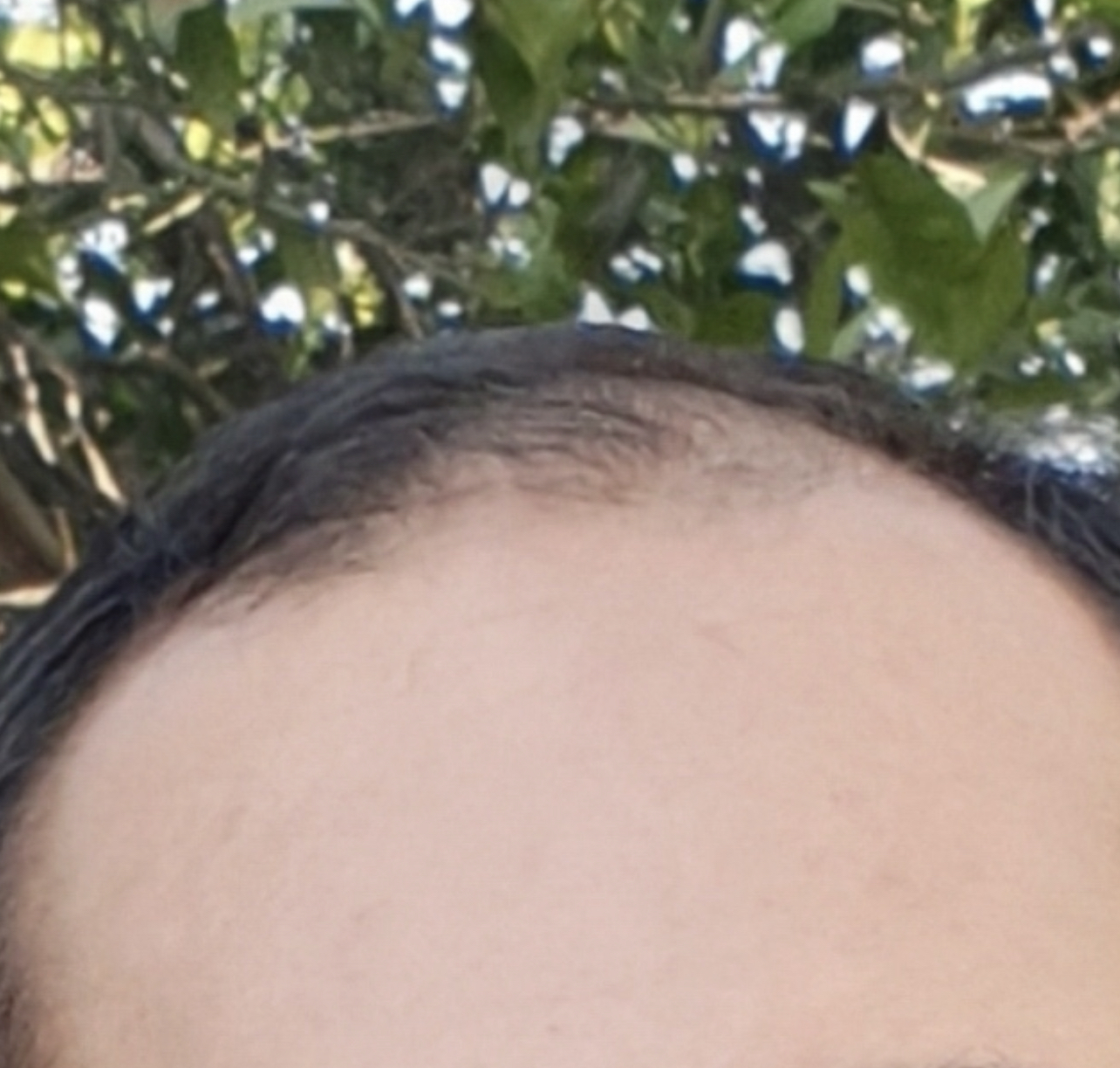[1]
Nistico S, Tamburi F, Bennardo L, Dastoli S, Schipani G, Caro G, Fortuna MC, Rossi A. Treatment of telogen effluvium using a dietary supplement containing Boswellia serrata, Curcuma longa, and Vitis vinifera: Results of an observational study. Dermatologic therapy. 2019 May:32(3):e12842. doi: 10.1111/dth.12842. Epub 2019 Feb 8
[PubMed PMID: 30693615]
Level 2 (mid-level) evidence
[2]
Sari Aslani F, Heidari Esfahani M, Sepaskhah M. Non-scarring Alopecias in Iranian Patients: A Histopathological Study With Hair Counts. Iranian journal of pathology. 2018 Summer:13(3):317-324
[PubMed PMID: 30636954]
[3]
Sahin G, Pancar GS, Kalkan G. New pattern hair loss in young Turkish women; What's wrong in their daily life? Skin research and technology : official journal of International Society for Bioengineering and the Skin (ISBS) [and] International Society for Digital Imaging of Skin (ISDIS) [and] International Society for Skin Imaging (ISSI). 2019 May:25(3):367-374. doi: 10.1111/srt.12662. Epub 2019 Jan 5
[PubMed PMID: 30614076]
[4]
Stoehr JR, Choi JN, Colavincenzo M, Vanderweil S. Off-Label Use of Topical Minoxidil in Alopecia: A Review. American journal of clinical dermatology. 2019 Apr:20(2):237-250. doi: 10.1007/s40257-018-0409-y. Epub
[PubMed PMID: 30604379]
[5]
Daly T, Daly K. Telogen Effluvium With Dysesthesia (TED) Has Lower B12 Levels and May Respond to B12 Supplementation. Journal of drugs in dermatology : JDD. 2018 Nov 1:17(11):1236-1240
[PubMed PMID: 30500148]
[6]
Asghar F, Shamim N, Farooque U, Sheikh H, Aqeel R. Telogen Effluvium: A Review of the Literature. Cureus. 2020 May 27:12(5):e8320. doi: 10.7759/cureus.8320. Epub 2020 May 27
[PubMed PMID: 32607303]
[7]
Tešanović Perković D, Vukojević M, Bukvić Mokos Z. Post-COVID Telogen Effluvium. Acta dermatovenerologica Croatica : ADC. 2022 Dec:30(4):220-226
[PubMed PMID: 36919388]
[8]
Bin Dayel S, Hussein RS, Atia T, Abahussein O, Al Yahya RS, Elsayed SH. Is thyroid dysfunction a common cause of telogen effluvium?: A retrospective study. Medicine. 2024 Jan 5:103(1):e36803. doi: 10.1097/MD.0000000000036803. Epub
[PubMed PMID: 38181279]
Level 2 (mid-level) evidence
[9]
Zhang D, LaSenna C, Shields BE. Culprits of Medication-Induced Telogen Effluvium, Part 1. Cutis. 2023 Dec:112(6):267-271. doi: 10.12788/cutis.0910. Epub
[PubMed PMID: 38290075]
[10]
Seyfi S, Alijanpour R, Aryanian Z, Ezoji K, Mahmoudi M. Prevalence of telogen effluvium hair loss in COVID-19 patients and its relationship with disease severity. Journal of medicine and life. 2022 May:15(5):631-634. doi: 10.25122/jml-2021-0380. Epub
[PubMed PMID: 35815081]
[11]
Sant'Anna Addor FA, Donato LC, Melo CSA. Comparative evaluation between two nutritional supplements in the improvement of telogen effluvium. Clinical, cosmetic and investigational dermatology. 2018:11():431-436. doi: 10.2147/CCID.S173082. Epub 2018 Sep 10
[PubMed PMID: 30237729]
Level 2 (mid-level) evidence
[12]
Udompanich S, Chanprapaph K, Suchonwanit P. Hair and Scalp Changes in Cutaneous and Systemic Lupus Erythematosus. American journal of clinical dermatology. 2018 Oct:19(5):679-694. doi: 10.1007/s40257-018-0363-8. Epub
[PubMed PMID: 29948959]
[14]
Motosko CC, Bieber AK, Pomeranz MK, Stein JA, Martires KJ. Physiologic changes of pregnancy: A review of the literature. International journal of women's dermatology. 2017 Dec:3(4):219-224. doi: 10.1016/j.ijwd.2017.09.003. Epub 2017 Oct 21
[PubMed PMID: 29234716]
[15]
Yorulmaz A, Hayran Y, Ozdemir AK, Sen O, Genc I, Gur Aksoy G, Yalcin B. Telogen effluvium in daily practice: Patient characteristics, laboratory parameters, and treatment modalities of 3028 patients with telogen effluvium. Journal of cosmetic dermatology. 2022 Jun:21(6):2610-2617. doi: 10.1111/jocd.14413. Epub 2021 Aug 27
[PubMed PMID: 34449961]
[16]
Jimeno Ortega I, Stefanato CM. Telogen effluvium: a 360 degree review. Italian journal of dermatology and venereology. 2023 Dec:158(6):457-466. doi: 10.23736/S2784-8671.23.07579-5. Epub
[PubMed PMID: 38015483]
[17]
Mirallas O, Grimalt R. The Postpartum Telogen Effluvium Fallacy. Skin appendage disorders. 2016 May:1(4):198-201. doi: 10.1159/000445385. Epub 2016 Apr 20
[PubMed PMID: 27386466]
[18]
Malkud S. Telogen Effluvium: A Review. Journal of clinical and diagnostic research : JCDR. 2015 Sep:9(9):WE01-3. doi: 10.7860/JCDR/2015/15219.6492. Epub 2015 Sep 1
[PubMed PMID: 26500992]
[19]
Kakpovbia E, Ogbechie-Godec OA, Shapiro J, Lo Sicco KI. Laboratory Testing in Telogen Effluvium. Journal of drugs in dermatology : JDD. 2021 Jan 1:20(1):110-111. doi: 10.36849/JDD.5771. Epub
[PubMed PMID: 33400415]
[20]
İbiş S, Aksoy Saraç G, Akdağ T. Evaluation of MCV/RDW Ratio and Correlations With Ferritin in Telogen Effluvium Patients. Dermatology practical & conceptual. 2022 Jul:12(3):e2022151. doi: 10.5826/dpc.1203a151. Epub 2022 Jul 1
[PubMed PMID: 36159144]
[21]
Saini K, Mysore V. Role of vitamin D in hair loss: A short review. Journal of cosmetic dermatology. 2021 Nov:20(11):3407-3414. doi: 10.1111/jocd.14421. Epub 2021 Sep 22
[PubMed PMID: 34553483]
[22]
Mysore V, Parthasaradhi A, Kharkar RD, Ghoshal AK, Ganjoo A, Ravichandran G, Saraswat A, Shah Y, Singh M, Remadevi TJ, Matte P. Expert consensus on the management of Telogen Effluvium in India. International journal of trichology. 2019 May-Jun:11(3):107-112. doi: 10.4103/ijt.ijt_23_19. Epub
[PubMed PMID: 31360038]
Level 3 (low-level) evidence
[23]
Randolph M, Tosti A. Oral minoxidil treatment for hair loss: A review of efficacy and safety. Journal of the American Academy of Dermatology. 2021 Mar:84(3):737-746. doi: 10.1016/j.jaad.2020.06.1009. Epub 2020 Jul 2
[PubMed PMID: 32622136]
[24]
Khattab FM, Rady A, Khashaba SA. Recent modalities in treatment of telogen effluvium: Comparative study. Dermatologic therapy. 2022 Oct:35(10):e15720. doi: 10.1111/dth.15720. Epub 2022 Aug 8
[PubMed PMID: 35851518]
Level 2 (mid-level) evidence
[25]
Mubki T, Rudnicka L, Olszewska M, Shapiro J. Evaluation and diagnosis of the hair loss patient: part I. History and clinical examination. Journal of the American Academy of Dermatology. 2014 Sep:71(3):415.e1-415.e15. doi: 10.1016/j.jaad.2014.04.070. Epub
[PubMed PMID: 25128118]
[26]
Hamm H. [Acquired alopecia in childhood]. Der Hautarzt; Zeitschrift fur Dermatologie, Venerologie, und verwandte Gebiete. 2013 May:64(5):371-9; quiz 380-1. doi: 10.1007/s00105-013-2554-9. Epub
[PubMed PMID: 23571647]
